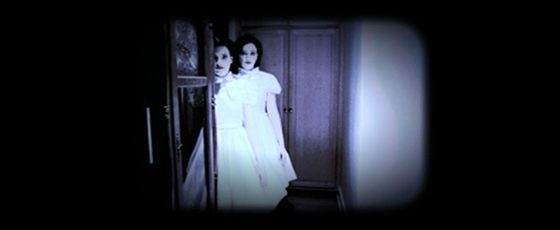Insidious ain't a great movie by any stretch. It's a derivative knockoff of Poltergeist with hints of the video game series Silent Hill in its final act. However, James Wan keeps the movie brisk and occasionally scary, and the first half of the film carries some potent energy and style. Despite his involvement with the Saw series, Wan clearly carries the heart of a more traditional horror filmmaker. His Dead Silence focuses on the classic case of the living puppet (never done so well as in the 1945 omnibus Dead of Night), and this film hearkens back to classic haunted house imagery.
I'm a huge nerd about horror history, so it's natural that I'd respond to this side of the movie, but one sequence stands out for both honoring the past and being really damned scary on its own. Obviously the latter's more important than the former, but getting both? That's a treat is what that is.
In the middle of the film, the creeped-out Lambert family hire a couple of low-rent ghost-busters to inspect their house. The men's equipment is mostly familiar, but researcher Tucker (Angus Sampson) has a handy little device that works like a viewmaster. He peers through the eyepiece, turns a lever on the side with a nifty little SHUCK sound effect, and he gets a new segment of the electro-magnetic spectrum. Or something. Anyway, the important point is that the movie's about to go monochrome and the music dips to emphasize the lever.
Nothing.
SHUCK. Nothing.
SHUCK. Come on, we know there's gotta be something in one of these--
SHUCKHOLYCRAP.
A quick check from our buddy Tucker...
Nothing's there.
Of course, something is there. The fun of this shot is knowing that those two girls are still standing right next to that clock, just outside our range of vision. A pair of grinning undead harpies. Ehrgh.
Along with functioning as a neat little scare scene, classically built up and executed, the image evokes the style of silent horror films like Nosferatu and The Cat and the Canary. Which also featured monochromatic tints. Now, it's entirely possible that this scene had no such purpose and simply has a stylistic similarity to those movies, but I don't think so. I think it's on purpose, and the big reason for that is the switch from the wideness of the film's 2:35 aspect ratio to the narrowness of the viewmaster. Which mimics the 4x3 aspect ratio of movies back in the 1920's.
The only alternative inspiration I can think of is old photographs, but those weren't tinted to different colors with the regularity of early horror films. Even if I'm wrong, the context suggests antiquity, which makes sense, because the ghosts are ancient, as is the story. Take us out, Cesare.
"..."








No comments:
Post a Comment